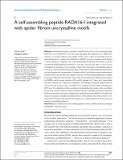A self-assembling peptide RADA16-I integrated with spider fibroin uncrystalline motifs
Author(s)
Sun, Lijuan; Zhao, Xiaojun
DownloadSun-2012-A self-assembling pe.pdf (2.432Mb)
PUBLISHER_CC
Publisher with Creative Commons License
Creative Commons Attribution
Terms of use
Metadata
Show full item recordAbstract
Mechanical strength of nanofiber scaffolds formed by the self-assembling peptide RADA16-I or its derivatives is not very good and limits their application. To address this problem, we inserted spidroin uncrystalline motifs, which confer incomparable elasticity and hydrophobicity to spider silk GGAGGS or GPGGY, into the C-terminus of RADA16-I to newly design two peptides: R3 (n-RADARADARADARADA-GGAGGS-c) and R4 (n-RADARADARADARADA-GPGGY-c), and then observed the effect of these motifs on biophysical properties of the peptide. Atomic force microscopy, transmitting electron microscopy, and circular dichroism spectroscopy confirm that R3 and R4 display ß-sheet structure and self-assemble into long nanofibers. Compared with R3, the ß-sheet structure and nanofibers formed by R4 are more stable; they change to random coil and unordered aggregation at higher temperature. Rheology measurements indicate that novel peptides form hydrogel when induced by DMEM, and the storage modulus of R3 and R4 hydrogel is 0.5 times and 3 times higher than that of RADA16-I, respectively. Furthermore, R4 hydrogel remarkably promotes growth of liver cell L02 and liver cancer cell SMCC7721 compared with 2D culture, determined by MTT assay. Novel peptides still have potential as hydrophobic drug carriers; they can stabilize pyrene microcrystals in aqueous solution and deliver this into a lipophilic environment, identified by fluorescence emission spectra. Altogether, the spider fibroin motif GPGGY most effectively enhances mechanical strength and hydrophobicity of the peptide. This study provides a new method in the design of nanobiomaterials and helps us to understand the role of the amino acid sequence in nanofiber formation.
Date issued
2012-02Department
Massachusetts Institute of Technology. Center for Biomedical EngineeringJournal
International Journal of Nanomedicine
Publisher
Dove Medical Press
Citation
Sun, Lijuan and Xiaojun Zhao. “A Self-Assembling Peptide RADA16-I Integrated with Spider Fibroin Uncrystalline Motifs.” International Journal of Nanomedicine (February 2012): 571.
Version: Final published version
ISSN
1178-2013
1176-9114